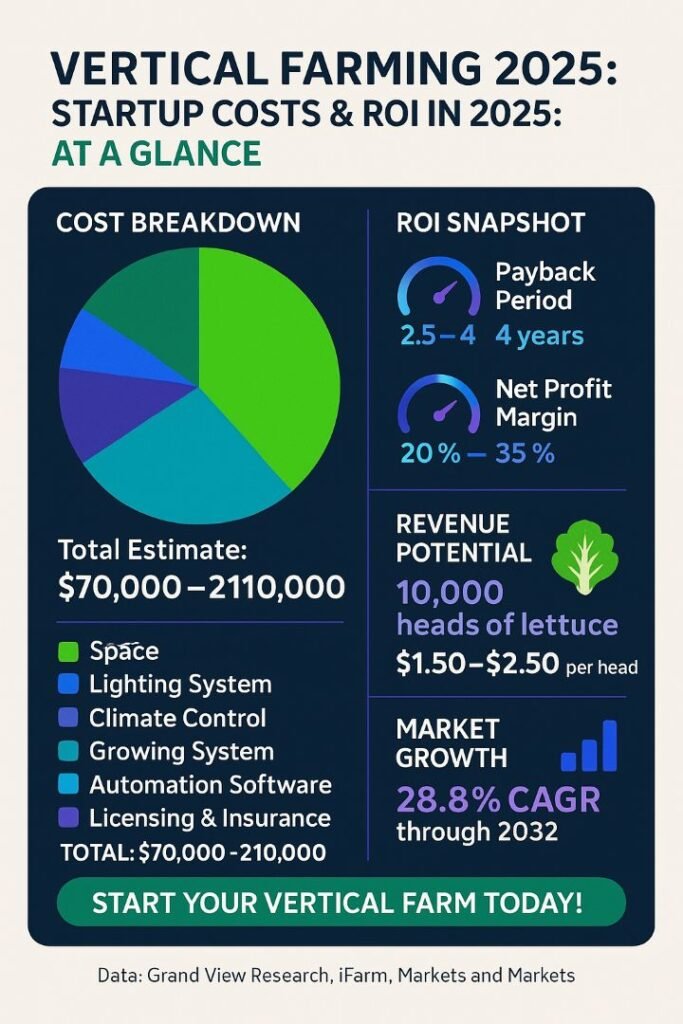Introduction
Vertical farming is revolutionizing agriculture, particularly in urban areas where land is scarce and demand for fresh produce is high. The vertical farming startup cost is a critical factor for entrepreneurs in the USA, UK, and Canada looking to enter this innovative industry. With urbanization and climate change driving the need for sustainable food production, vertical farming has gained traction across Western countries. This article provides a comprehensive breakdown of the costs involved in setting up a vertical farm and an in-depth ROI analysis to help you determine if this venture is worth your investment. If you’re thinking of starting a vertical farm, here’s what it’ll really cost—and what returns you can expect.

What is Vertical Farming?
Vertical farming is the practice of growing crops in vertically stacked layers, typically indoors, using soil-less techniques such as hydroponics, aeroponics, or aquaponics. Unlike traditional farming, it relies on controlled environments with artificial lighting and climate control to produce crops year-round. This method maximizes space efficiency, making it ideal for urban settings.
Types of Vertical Farming
- Hydroponics: Plants grow in nutrient-rich water, eliminating the need for soil.
- Aeroponics: Roots are misted with nutrient solutions, offering high efficiency in water use.
- Aquaponics: Combines fish farming with plant cultivation, where fish waste provides nutrients for plants.
Why It’s Trending in Western Countries
The popularity of vertical farming in the USA, UK, and Canada stems from urban land shortages, unpredictable weather due to climate change, and growing consumer demand for locally grown, pesticide-free produce. For instance, the U.S. vertical farming market was valued at USD 735.6 million in 2023 and is projected to grow at a CAGR of 19.1% through 2030, driven by these factors.
Initial Setup Cost for Vertical Farming
Starting a vertical farm requires significant upfront investment. Below is a detailed breakdown of the vertical farming startup cost for a small to medium-scale operation (approximately 1,000 sq. ft).
1. Facility/Space Cost
Securing a suitable space, such as a warehouse or indoor facility, is the first step. In the USA, renting a warehouse costs between $15–$40 per square foot per year, depending on the location. Urban areas like New York or San Francisco are on the higher end, while rural areas may be cheaper. In the UK, costs range from £10–£25 per sq. ft, and in Canada, CAD 12–30 per sq. ft. For a 1,000 sq. ft space, expect to spend $15,000–$40,000 annually in the USA.
2. Lighting System
LED grow lights are essential for indoor farming, mimicking sunlight to promote plant growth. On average, high-quality LED lights cost $100–$300 each, with a small farm requiring 50–100 units. For a 1,000 sq. ft farm, lighting costs range from $10,000–$25,000. Advances in LED technology have made these systems more affordable, significantly reducing the vertical farming startup cost compared to a decade ago.
3. Climate Control & HVAC
Maintaining optimal temperature, humidity, and CO₂ levels is crucial. HVAC systems, dehumidifiers, and CO₂ regulators can cost between $15,000–$50,000 for a small to medium setup, depending on the complexity and scale. These systems ensure consistent crop yields year-round, a key advantage of vertical farming.
4. Hydroponic/Aeroponic System
The growing system—whether hydroponic, aeroponic, or aquaponic—includes reservoirs, pumps, trays, and sensors. For a 1,000 sq. ft farm, expect to invest $20,000–$70,000. Hydroponics is generally the most cost-effective for startups, while aeroponics requires more advanced equipment but offers faster growth.
5. Automation & Software
Automation systems, including smart sensors, IoT devices, and farm management software, streamline operations and reduce labor costs. These systems typically cost $5,000–$15,000 for a small farm. Companies like 80 Acres use AI-driven software to optimize crop growth, demonstrating the value of automation in reducing the vertical farming startup cost over time.
6. Labor and Training
Skilled technicians are needed to manage vertical farms. In the USA, a technician’s salary ranges from $3,000–$6,000 per month, while in the UK and Canada, it’s roughly £2,000–£4,000 and CAD 3,500–6,500, respectively. Initial training for staff may cost an additional $1,000–$5,000 to ensure efficient operation.
7. Licensing, Insurance, and Permits
Legal requirements vary by region. In the USA, permits and licenses for agricultural operations cost $2,000–$10,000, depending on local regulations. The UK and Canada have similar ranges (£1,500–£7,000 and CAD 2,500–10,000). Insurance for equipment and liability adds to this cost.
Total Estimated Startup Cost Table
Here’s a summarized breakdown of the vertical farming startup cost for a 1,000 sq. ft farm:
| Category | Estimated Cost (USD) |
|---|---|
| Space (1,000 sq. ft) | $20,000–$40,000 |
| Lighting System | $10,000–$25,000 |
| Climate Control | $15,000–$50,000 |
| Growing System | $20,000–$70,000 |
| Automation Software | $5,000–$15,000 |
| Licensing & Insurance | $2,000–$10,000 |
| Total Estimate | $70,000–$210,000 |
Note: Costs may vary based on location, scale, and technology used.

ROI & Profitability Analysis
Understanding the return on investment (ROI) is crucial when evaluating the vertical farming startup cost. Here’s how profitability breaks down.
Revenue Potential
Vertical farms typically focus on high-yield crops like lettuce, herbs, strawberries, and microgreens. For a 1,000 sq. ft farm, you can produce approximately 10,000 heads of lettuce per month. At a wholesale rate of $1.50–$2.50 per head, monthly revenue could range from $15,000–$25,000. Microgreens, which command higher prices ($10–$20/lb), can further boost revenue.
Operating Costs
Ongoing expenses include:
- Electricity: $2,000–$5,000/month, primarily for lighting and climate control.
- Labor: $3,000–$6,000/month for skilled technicians.
- Consumables: Seeds, nutrients, and water cost $1,000–$2,000/month.
Total monthly operating costs typically range from $6,000–$13,000.
Break-Even Timeline
Assuming a $100,000 initial investment and a net profit margin of 20%–35%, the payback period is approximately 2.5–4 years. This timeline aligns with industry estimates, such as iFarm’s projection of a 4–6 year payback for a 1,000 sq. ft farm. Factors like crop selection and market demand significantly influence this timeline.
Is Vertical Farming a Good Investment in 2025?
Despite the high vertical farming startup cost, the industry offers promising opportunities. The global vertical farming market is projected to grow from $8.52 billion in 2025 to $50.10 billion by 2032, with a CAGR of 28.8%. Growing consumer demand for local, pesticide-free produce and government incentives in the USA and Canada (e.g., Canada’s greenhouse expansion programs) make vertical farming an attractive investment. However, high operational costs, particularly energy, remain a challenge. Only 27% of vertical farms are currently profitable due to electricity expenses, which account for 60% of revenue in some cases.
Pro Tips for Cost Optimization
To maximize ROI and reduce the vertical farming startup cost, consider these strategies:
- Start Small and Scale: Begin with a 500 sq. ft setup to test the market before expanding.
- Use Second-Hand Infrastructure: Purchase used equipment like HVAC systems or grow lights to cut costs.
- Opt for High-ROI Crops: Focus on fast-growing crops like microgreens or herbs for quicker returns.
- Leverage Automation: Invest in IoT sensors and AI-driven software to reduce labor expenses over time.
Conclusion
The vertical farming startup cost in 2025 ranges from $70,000–$210,000 for a 1,000 sq. ft farm, with a potential payback period of 2.5–4 years. While the initial investment is significant, the growing demand for sustainable, local produce and advancements in technology make vertical farming a viable venture in the USA, UK, and Canada. Thorough research, careful financial planning, and consultation with experts are essential for success. Looking to start your own vertical farm? Begin with a clear cost and ROI model for long-term success.
Related Resources
Related Articles on Vertical Farming
Explore more insights on vertical farming to deepen your understanding of this sustainable agricultural revolution. Check out these articles for actionable tips, trends, and strategies to succeed in the industry:
- Vertical Farming: A Sustainable Solution for Modern Agriculture: Learn the essential steps to launch your own vertical farm, from planning to execution, tailored for beginners in the USA, UK, and Canada.

